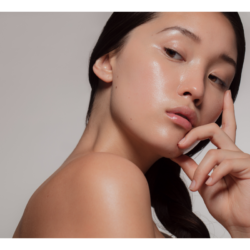Finding the right foundation colour for your skin tone is fairly simple, as long as you know how to go about it! Otherwise, mistakes can be made very quickly, leading to unpleasant demarcations that we’d all prefer to avoid (just think of the uncompromising gaze of your car’s rear-view mirror! ). In this section, you’ll find all the advice you need to choose the right shade of foundation for your skin tone. You’ll also find brand-name products from your online organic pharmacy for a successful make-up application.
How to find your ideal shade?
Simply apply a small amount of product to the bottom of your cheek, at jawline level. On completely cleansed skin. In addition, make sure the lighting is as natural as possible to avoid any surprises once you’re outside.
Skin tone, often referred to as skin colour, is a fundamental aspect of choosing your foundation. This shade, which varies from white to black, is mainly determined by melanin, a natural pigment present in the epidermis. Understanding your skin tone is crucial to selecting a foundation that perfectly matches your natural complexion. Skin tone is not static and can vary slightly under the influence of external factors such as sun exposure.
Undertone: The skin’s hidden tone
Skin undertone is the underlying tone that influences the overall appearance of your skin tone. It is classified into three main categories:
- Warm undertones: These tend towards yellow or golden tones, giving the skin a slightly brighter or sunnier appearance.
- Cool undertones: Characterised by pink or bluish tones, these undertones give the skin a paler or porcelain appearance.
- Neutral undertones: A blend of warm and cool tones, offering perfect balance and versatility in the choice of foundation colours.
Identifying the undertone: A simple guide
To determine your skin’s undertone, observing the veins on the inside of your wrist is a quick and effective method. Here’s how to do it:
- Blue or violet veins: If the veins appear this colour, you have a cool undertone. Foundations with pinkish or bluish undertones are generally the most suitable for these undertones.
- Greenish veins: This vein colour suggests you have a warm undertone. In this case, foundations with yellow or gold undertones will be more in harmony with your skin.
- Difficulty Discerning Colour: If you can’t clearly identify the colour of your veins, it’s likely that you have a neutral undertone. Foundations with neutral shades are often a safe choice for these undertones.
Understanding these elements – skin tone and undertone – is essential to choosing a foundation that not only matches your natural skin tone but also enhances your natural beauty.
Bring out your best jewellery
Some people prefer silver or gold jewellery. If you like the look of traditional yellow gold on your skin, you probably have warm or olive tones.Silver, platinum and rose gold tend to look more flattering on cooler shades. If you tend to wear both silver and gold and choose your colour according to your outfit rather than your skin colour, you probably have neutral undertones.
What is a foundation?
A must-have in every make-up bag, foundation plays a crucial role in creating an even, radiant complexion. It masks imperfections, evens out the complexion and provides a blank canvas on which other make-up products can be applied. This cosmetic product, available in various forms such as liquid, powder, cream or mousse, is designed to suit different skin types and aesthetic needs.
What is foundation used for?
The main function of foundation is to balance skin tone by masking imperfections such as redness, spots, scars or signs of fatigue. It also helps protect the skin against environmental factors such as pollution and UV rays, especially if it contains a sun protection factor. What’s more, it acts as a base for other make-up products, ensuring better hold and more even application.
Types of foundation
There are many different types of foundation, each with its own specific benefits. Liquid foundations are perfect for even application and are suitable for almost all skin types, especially dry skin because of their moisturising formulation. Powder foundations, on the other hand, are ideal for oily or combination skin, as they help to mattify the skin and control excess sebum. Cream foundations offer high coverage and are suitable for mature or dry skin, while light foams are suitable for sensitive skin and those looking for a natural finish. Each type has its own characteristics, making it possible to choose the product best suited to each specific need.
Choosing the right shade of foundation
Selecting the ideal shade of foundation is a crucial step in achieving a natural, harmonious look. To do this, it’s advisable to perform the colour test not on the wrist, but on the jawline. This method allows you to find a precise match with the skin on your face, ensuring a natural, seamless transition with the neck. Apply a small amount of product to the jaw line and blend lightly to see how the shade blends with your skin.
Avoid lines: Perfectly blend with skin tone
The right foundation should blend imperceptibly with your natural skin tone. Check carefully that the shade you choose blends perfectly with your skin tone, without creating visible lines or demarcations, particularly around the jawline and neck. This continuity of colour ensures a natural effect and avoids an artificial or masked look.
Natural light: the importance of an outdoor test
Natural light is your best ally for assessing the true shade of foundation. Artificial lighting inside shops can alter colour perception. Take the time to go outside and observe the foundation in natural light. This will give you a true idea of how the shade interacts with your skin tone in real lighting conditions, avoiding any unpleasant surprises once you’re outside.
Allow the product to oxidise: Test wear over several hours
Before finalising your purchase, it’s a good idea to wear your foundation for several hours. This is crucial because foundation shades can change slightly over the course of the day, due to oxidation and interaction with your skin’s natural oils. Make sure that the shade remains even and satisfactory even after several hours of application to guarantee a choice that will suit you over time.
Quality products for the ultimate beauty makeover
Choosing a foundation based on the needs and nature of your skin is essential for a successful makeover! Whether your skin is dry, oily or combination, Soin et Nature will help you make the right choice in terms of products for the complex ion.
For an even complexion, remember to take care at every stage of your make-up routine. Avril organic foundation 30ml, the foundation that takes care of your skin. Rich in jojoba oil, it moisturises and nourishes your skin. Its light, fluid texture is ideal for oily skin and enhances your complexion while giving it a natural look.
Apply it to your cheekbones, chin, forehead and neck, not forgetting your décolleté. Then work the material over the whole of the mobile eyelid with light eyeshadows and vapours. Separate the lashes with a light mascara.
To illuminate your complexion in a flash, opt for Avène Couvrance Fluid Foundation. This foundation will help you achieve a perfect make-up look. With moderate coverage (14% pigments), it helps you conceal dark circles for an ever more luminous look. The formula of the couvrance foundation is particularly gentle and ensures that your make-up stays put, resisting water, sweat and rubbing. It has anti-UV SPF 20 sun protection, providing anti-ageing protection.
Mistakes to avoid when choosing your foundation
Avoiding a shade too far from your natural skin tone and selecting a product suited to your skin type are key steps in ensuring that your foundation looks natural and harmonious.
Shades that are too light or dark: Go for harmony with your natural skin tone
One of the most common mistakes in choosing a foundation is selecting a shade that is too far removed from your natural skin tone. Opting for a shade that’s too light in the hope of illuminating the face, or a darker shade to simulate a tan, can be counterproductive. An inappropriate choice of shade can result in an unnatural effect, sometimes giving a sickly look or a visible demarcation between the face and neck.
Light skin tones
Recommended colours
For fairer skin tones, it’s best to choose a foundation that matches your skin’s natural colour as closely as possible, without tending towards pink or yellow. Ivory, light beige or porcelain shades are often the most suitable. It’s important to choose light, luminous formulas that enhance the freshness of the complexion without weighing it down.
Mistakes to avoid
A common mistake for fair skin is to choose a foundation that is too dark in order to appear more tanned. This creates a blatant mismatch between the face and the neck, giving an unnatural effect. It’s also advisable to avoid foundations with a strong yellow or pink undertone, which can give a sickly look.
Medium skin tones
Recommended colours
People with medium skin tones have the advantage of being able to wear a wider range of colours. Shades such as natural beige, honey or golden are often wise choices. These shades help to even out the complexion while maintaining a natural, radiant look.
Specific advice
For medium skin tones, it is important to take into account the undertones of the skin. If your skin has warm undertones, opt for foundations with slightly golden tones. If it has cool undertones, opt for more neutral or slightly rosy shades.
Darker skin tones
Recommended colours
Darker skin tones benefit greatly from foundations that offer natural coverage without dulling the complexion. Shades of caramel, bronze or chocolate are recommended, depending on the intensity of the skin tone. It’s essential to choose a product that blends harmoniously with the skin.
Tips to avoid a mask effect
To avoid a mask effect, it’s crucial to blend foundation well, especially around the hairline, neck and ears. Using a foundation with a modular formula, which allows you to build up the desired coverage, can also help to achieve a more natural, less uniform result.
Matching skin needs: Choosing according to skin type
Foundation selection isn’t just about colour; the product’s texture and formula are just as important. It’s crucial to choose a foundation that matches the specific needs of your skin type to achieve an optimal, comfortable result all day long.
- For Oily Skin: Choose a mattifying foundation. These formulas are designed to control excess sebum and maintain a matte, even appearance. They help to reduce shine and refine skin texture, giving a smoother, longer-lasting finish.
- For Dry Skin: Opt for a moisturising foundation. These products contain nourishing ingredients that help hydrate the skin, preventing the appearance of dry patches or flaking. A moisturising foundation guarantees a luminous finish and continuous comfort, preventing the skin from pulling or looking dull.
By taking these aspects into account when choosing your foundation, you can not only improve the appearance of your skin, but also contribute to its well-being and health. A well-chosen foundation is an invaluable ally in your beauty routine, so select it with care and attention.




